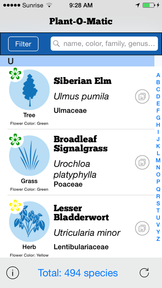
For those of you interested in the finer details, there have been some delays in the review process (ironically, this relates to my previous post). Please find below an abstract of the manuscript currently in review and do not hesitate to contact me if you wish to have a complete copy.
ABSTRACT
1. Advances in both informatics and mobile technology are providing exciting new opportunities for generating, disseminating, and engaging with information in the biological sciences at unprecedented spatial scales, particularly in disentangling the natural history of hyperdiverse groups of organisms.
2. We describe a mobile field guide application to all of the plants of the Americas developed using species distribution models estimated from field observations of plant occurrences. The underlying data comprise over 3.5 million standardized observations of over 88,000 plant species.
3. Plant-O-Matic, a free iOS application, combines the species distribution models with the location services built into a mobile device to provide users with a list of all the plant species expected to occur in the 100 × 100 km geographic grid cell corresponding to the their location. The application also provides ancillary information on species’ attributes (when available) including growth form, reproductive mode, flower color, and common name. Results can be searched and conditionally filtered based on these attributes. Links to externally sourced specimen images further aid the identification of species by the user.
4. The application’s ability to assemble locally-relevant lists of plant species and their attributes anywhere in the Americas provides a powerful new tool for identifying, exploring, and understanding plant diversity. Mobile applications such as Plant-O-Matic can facilitate dynamic new approaches to science, conservation and science education.
 RSS Feed
RSS Feed
